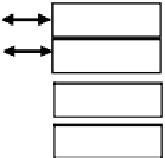Information Technology Reference
In-Depth Information
to perform the movement. It uses a realtime magnetic position and orientation track-
ing system. The tracking system produces coordinate information at a speed of 240
Hz, which is fast enough to capture dexterous hand motions which are below 25 Hz.
The digital forceps streams coordinate information.
The second component is a set of video sources which stream video frames at 30
Frames Per Second (30 fps). Multiple video sources including a pair of cameras cap-
turing the live view of the hand motion to perform the surgical tasks are shown. It also
has video input from the storage as well as the ability to store stereo video.
The third component is a foot-pedal control that adjusts the zoom and focus of the
digital stereo microscope.
The fourth component is a mechanism to stream the statistics information about the
surgical motion such as the number of movements made, the time taken, and the qual-
ity measure of the movements.
DSM Forceps
Listener
DSM Pose
Generator
Digital For-
ceps
Forceps
Reader
S Buffer
T Buffer
Vertex
Buffer
DSM Real-
time Engine
DSM Stats and Configuration
Client
DSM Stats
and Config
Foot Pedal Control Com-
mands
DSM
Grap
hics
Pipe-
line
R Buffer
DSM Storage
Listener
DSM
Storage
L Buffer
R Buffer
Video
Reader
D Buffer
E Buffer
L Buffer
DSM Camera
Listener
Camera
Back
Buffer
Camera
Reader
Display
B Buffer
C Buffer
Fig. 2.
Software Defined Stereo Microscope
These four components form a software defined surgical microscope. It is similar in
function as an optical surgical microscope with the added facilities of programmability



























Search WWH ::

Custom Search